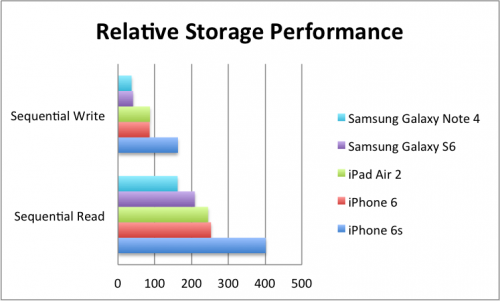We all knew that the iPhone 6s and iPad pro would boast anPU and graphics performance to challenge mainstream PC’s, but it has now been revealed that the storage layer packs revolutionary NVMe/PCIe connectivity and performance. Although the iPhone 6s doesn’t need this kind of performance, the forthcoming iPad Pro ought to rock!
No More SD Storage
In reviewing the iPhone 6s, the ever-thorough AnandTech uncovered an interesting fact: The flash storage was now enumerated as a PCIe device. This is a major change from every previous iPhone, and indeed from all previous ARM devices. Just about every existing ARM phone or tablet addresses flash storage just like an SD card, using the the SDIO/eMMC specifications. This delivers slow performance and sub-optimal integration and lifespan for NAND flash chips.
The result of this newfound PCIe storage is phenomenally-better storage performance for the iPhone 6s1 to go along with amazing CPU and graphics advances. Apple’s new A9 platform looks like more of an advance than any previous ARM CPU generation, and this storage change is very welcome.

Advantage PCIe
As I’ve written time and time again, the move from block SCSI disk controllers to PCIe and NVMe in SSD’s is truly a revolution. Beyond the obvious performance advantages, it makes architectural sense to treat flash as memory instead of as a disk drive. Since, after all, that’s what it is!
You should definitely read “Why Are PCIe SSDs So Fast?“
When Apple transitioned the MacBook line to PCIe SSD’s, performance improved dramatically. Today’s low-end MacBook Air, for example, boasts storage performance that beats every SATA SSD on the market. This storage is also better-integrated physically into these slim laptops, and likely yields improvements to cooling and battery life as well.
Toward Integrated Storage
But one big thing is missing from Apple’s PCIe laptops: True OS integration. Although Mac OS X includes SSD-friendly features like TRIM, it still treats this PCIe-connected flash as if it were an old fashioned hard disk drive. One reason for this is the fact that the operating system and applications expect an old-fashioned storage platform with a filesystem, volume manager, and block storage. Moving to an object-based storage platform would be a massive disruption in a UNIX operating system.2
The situation is different for the iOS operating system used in the iPhone and iPad. Apple enjoys complete autonomy to change iOS internals at will, and applications already must work within a limited, sandboxed storage environment. As noted, an object/database storage platform would be more in line with Apple’s iCloud, which forms a critical piece of the iOS experience. This could be extended to offer direct integration with flash storage in the future.
Indeed, Apple already offers a filesystem compatibility layer for iCloud. New in iOS 9 and current versions of Mac OS X is an iCloud explorer interface, iCloud Drive. This could be the basis for future moves to transition iOS to an object store from the current simple filesystem.3
iPad Pro: Better and Better!
Although Apple has not yet released the iPad Pro, and reviewers are presumably still under embargo, one can draw some interesting conclusions from this revelation. Since the iPad Pro uses the same A9 CPU platform as the iPhone 6s (albeit in enhanced A9x form), one can assume that it also uses this new PCIe storage interface. In fact, it’s likely that this interface was developed for the iPad Pro not the iPhone.
So the iPad Pro will offer revolutionary storage performance for an ARM tablet, likely rivaling the integrated storage in Intel Atom and Core tablets. And considering the blistering CPU and graphics performance of the A9, one can expect that the iPad Pro will indeed live up to its billing, beating “80 percent” of existing laptop PC’s.
Stephen’s Stance
This seemingly-small change from SD to PCIe storage has major implications for Apple’s ARM iPhone and iPad platform. Because they are hobbled by their storage interface, other ARM-based solution can’t truly compete with Intel’s PC platforms. This change further differentiates Apple from the Android crowd.
Note: As of now, the exact nature of Apple’s iPhone 6s storage interface is unconfirmed, and no information is available about the iPad Pro. For that reason, this entire article might prove premature of plainly incorrect!
My sincere apologies to the fine folks at AnandTech – I typed “Ars Technica” instead of “AnandTech” by accident. I’ve fixed it!
- The performance benefit for random I/O is masked by other bottlenecks. Likely, it’s the benchmark’s use of a queue depth of one. ↩
- I suspect that Apple will eventually move to a new filesystem with an object/database back-end. This would yield major improvements in cloud (iCloud) integration as well as native PCIe storage compatibility. But I’m sure they’ll include an HFS+ compatibility layer as well. ↩
- Ironically, it was Apple’s own Newton OS that introduced the world’s first (semi)successful object-based storage platform, known as “Soup.” The Newton also launched the ARM CPU platform! ↩
“Because they are hobbled by their storage interface, other ARM-based solution can truly compete with Intel’s PC platforms. This change further differentiates Apple from the Android crowd.”
Didn’t you mean “can’t truly compete” ?
Yep. Oops! Fixed!
The fact that the flash storage is now enumerated as a PCIe device is interesting because due to this change the storage performance can be expected far better for iPhone 6s. The figure which shows the comparison between different phones is nice.